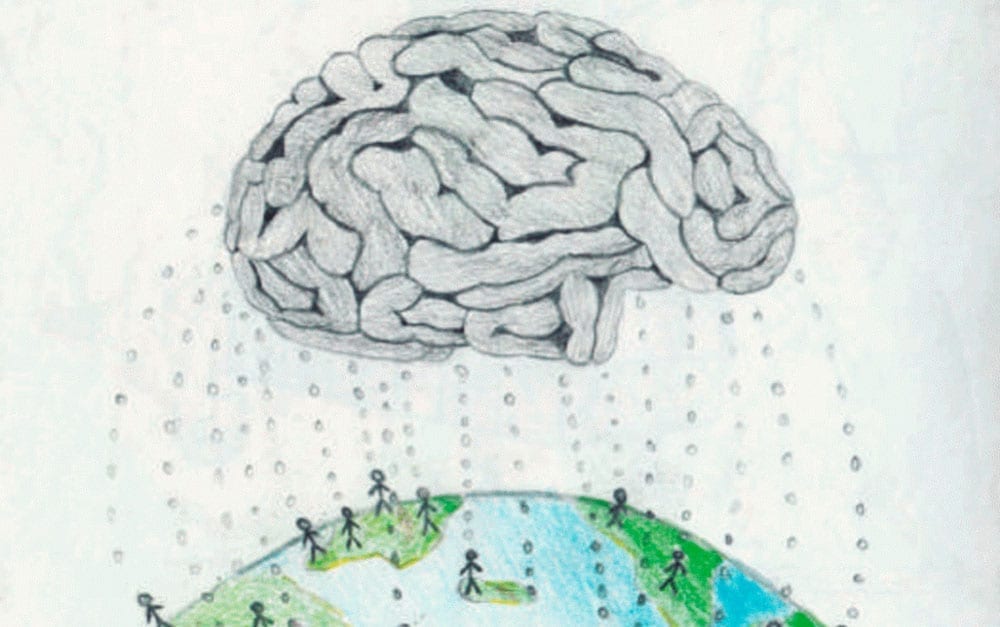A Dream of a Low Carbon Future
“When an idea is sketched on a page, it can be examined and discussed much more easily than when it merely exists in people’s heads.” In this blog, CUSP Fellow James McKay introduces his recent project: A dream of a low carbon future.

If you’ve ever wondered what the future will look like, if you are concerned about humanity’s impact on the planet – and don’t know how we can make positive changes – then this is a project for you.
We asked hundreds of school children, artists, writers, various members of the public, PhD students and academics to contribute pictures and stories of their visions of the future, and produced a graphic novel based on their ideas.
‘A Dream of a Low Carbon Future’ imagines the UK in the year 2150 – as a sustainable, low-carbon, prosperous society. It’s not a fantasy utopia – there are still conflicts and political problems: it represents a wildly optimistic but plausible vision of where we might end up if we can solve the problems resulting from climate change impacts. Importantly, the vision doesn’t shy away from imagining the kind of climate change impacts that scientists have predicted for the next hundred years or so.
How the project started
The project was born out of outreach activities undertaken by PhD students in the EPSRC Centres for Doctoral Training in Low Carbon Technologies and Bioenergy at the University of Leeds. PhD students on this programme do an ‘Integrated PhD and MSc’, and the MSc part involves a training package that includes outreach and dissemination activities.
Students had already run activities designed to raise awareness of energy and climate change issues at venues such as the Green Man Music Festival (Einstein’s Garden), the British Science Festival and Cheltenham Science Festival.
As manager of the Centres for Doctoral Training (CDTs for short), I helped to coordinate these outreach activities. I grew to be really inspired by the students’ work and learned a huge amount from them about their highly interdisciplinary research in areas such as solar energy, wind, bioenergy, carbon capture and storage, energy service companies, the ethics of introducing electric vehicles, district heat, geoengineering, and effects of alternative fuels on the atmosphere.
I am a comics artist by background (having arrived in the job of managing PhD research by a very roundabout route!) and I decided to help and further develop their work with the support of a Royal Academy of Engineering INGENIOUS grant – a scheme that funds innovative, interdisciplinary and creative outreach projects, both to raise awareness of engineering, and also to train engineers in public engagement. We secured £25k to put our project to practice.
Project activities
The idea was to run classes in schools where the PhD students would develop children’s awareness of energy and climate change issues, and then get them to think about what a sustainable, prosperous future would look like. My role was to guide the classes in terms of the art and creative writing. The classes took place in many different forms, for example one group consisted of 120 children (!) who came to the University campus and visited our laboratories to do the session. Another class was for disabled children from Great Ormond Street hospital in London. Most of the schools sessions were based around a common set of activities, the bulk of which involved the children conversing with the PhD researchers while they drew short comics, or wrote stories about characters living in the future.
Following the sessions, I and other comics artists developed the children’s ideas. We produced a 100 page colour graphic novel – ‘Dreams of a Low Carbon Future’ – which was launched in November 2013 to great acclaim. This first novel resembled a scrapbook of ideas – there were visions of lots of different futures depending on the choices we make, and the book also featured a lot of the children’s original artwork. They were thrilled to have their work published – it was especially pleasing to see the reactions of children who had not had this kind of opportunity before.
Having completed the project, we realised that we still had a huge amount of raw material, including original artwork, sketches, thoughts, and a book of ideas. What to do with them? Almost without pausing for breath, we started work on the second book. This was to be a much more coherent account of one particular positive vision that all the children and PhD students had developed. We continued with all the activities that we’d developed for the first project – funded and supported by the EPSRC CDT grant as part of the PhD students’ programme. In the meantime, I secured funding from the University of Leeds to print 2500 copies of the new book.
‘A Dream of a Low Carbon Future’ was launched in November 2016 at Thought Bubble Comics Festival (one of the biggest comics festivals in the UK). An exhibition of artwork from the book was held at the end of November as part of the ‘Nature of Prosperity’ dialogues hosted by the Centre for Understanding Sustainable Prosperity (CUSP) in London. Events are planned throughout the new year, including a joint schools session led by CUSP scholars based on the template of the INGENIOUS activities – a great example of the work becoming a legacy which can be used and adapted by others.
The graphic novel is available ![]() online (PDF, 20MB).
online (PDF, 20MB).
